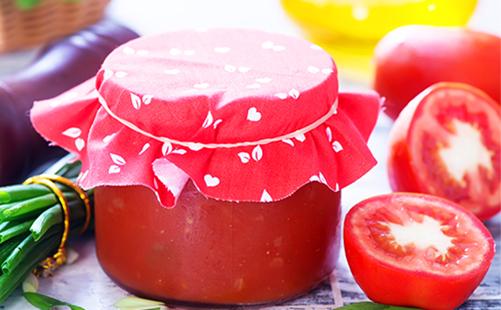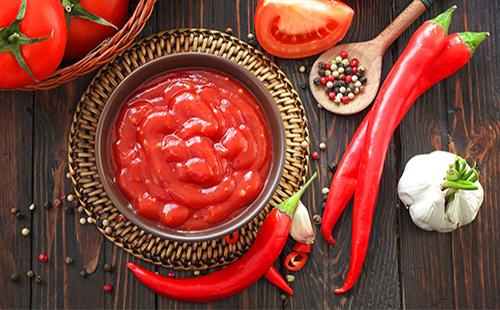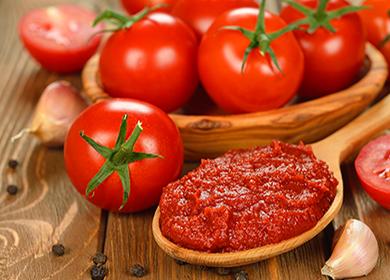According to GOST, tomato paste is a product of grated tomatoes, which contains at least 25% and not more than 40% of dry matter. If the water in the composition exceeds 40% - this is tomato puree, not pasta. A good pasty product is easy to check: the spoon sticks well, does not fall to one side.
Preliminary calculations
Before preparing tomato paste from fresh tomatoes, calculations should be made to understand how many ingredients are needed for the desired volume. Usually in the cooking process occurs double welding. Excess moisture evaporates, only thick tomato pulp remains in the pan. The table calculates the amount of ingredients from which you can get half a liter, liter or 2 liters of finished paste.
Table - Calculation of ingredients depending on the volume of containers
| Ingredients | Jar 500 ml | 1 l can | Can 2 L |
|---|---|---|---|
| Tomatoes | 1.5-2 kg | 2.5-3 kg | 4-5 kg |
| Sugar | 50 g | 50-100 g | 100-200 g |
| Salt | 30 g | 30-40 g | 80-100 g |
Cooking features
Before proceeding with a step-by-step recipe, you need to familiarize yourself with the features of cooking, so as not to be disappointed with the result. If the hostess has never cooked pasta and does not understand what exactly should be the result, six main nuances will give an idea of the cooking process.
- Fruit selection. For pasta, meaty and ripe tomatoes should be selected. Green or dense fruits with lots of seeds and fluids will not work - they will have to be boiled for a long time. In addition, ripe fleshy fruits are much more aromatic and tastier. Rotten, overripe, bursted tomatoes should also be removed.
- The preparation of tomatoes. Skins and seeds in tomato paste are not needed. It is necessary to get rid of them. To do this, incised crosswise fruits are blanched - scalded with boiling water, or dipped for three minutes in boiling water. After this procedure, the skin is easily removed. Get rid of the peel in another way: boil the tomato slices, then grind through a sieve.
- Shredding. The peeled tomatoes are ground together with the seeds with a juicer, a blender, a meat grinder, a food processor, and grated. The resulting puree is passed through a sieve to remove large particles and seeds.
- Selection of herbs and spices. Everything here is purely individual. Tomato paste, unlike ketchup, does not imply additional spices and seasonings. It’s not even necessary to sweeten and salt it. If you want to add a spicy aroma to dressing, it is recommended to take oregano, coriander, basil, parsley, paprika, red pepper.
- Getting rid of fluid. The most difficult part of the tomato paste recipe is to achieve density. To achieve the required consistency, you can use one of the ways to get rid of excess moisture. The easiest way is to boil tomato puree in a pan, not forgetting to stir, or evaporate in the oven (it will take one and a half to two hours). You can also hang the mashed potatoes in a dense gauze bag over the container and leave overnight. Excess moisture will drain itself.
- Sterilization. Not everyone likes to sterilize banks - it takes time and effort, and in the conditions of summer heat adds discomfort. However, without sterilization, the workpieces will not be stored for long. It is necessary at least to scald the cans with boiling water several times and dry. You can sterilize with an oven or microwave. Just pour a little water into the container, set to heat for several minutes.
Classic tomato paste recipe and original variations
Below are the recipes for homemade tomato paste for the winter in the classic version and with the addition of various seasonings, vegetables, fruits. Having understood the principle of preparation, culinary experts can experiment with the ingredients on their own.
Traditional
Description. This is the “basic” way to cook tomato paste at home. If desired, the workpiece can be salted, but it is recommended to do without any spices. It turns out 100% natural product.
What is necessary:
- tomatoes - depending on the volume of the container;
- salt is optional.
How to do
- Cut into large slices (just cut into four parts).
- Fold tightly in a saucepan to the very top, put on medium heat.
- Wait for boiling, boil for about half an hour (make sure that the juice does not run away).
- Place the strainer over a clean pan.
- Spread boiled tomatoes in small portions, wipe with a spoon through a sieve.
- Throw out the resulting cake, and put the mashed pulp on the fire.
- Boil for about three hours, stirring occasionally.
- When the liquid becomes half as much, continue cooking, stirring constantly, so that the juice does not stick.
- Having achieved the desired consistency, remove the pan from the stove, pour the contents into prepared sterile containers.
- Leave to cool upside down.
Onion
Description. Tomato paste is aromatic and spicy. Salt and sweeten the workpiece at your discretion, focusing on the calculation table and the variety of fruits.
What is necessary:
- tomatoes - 3 kg;
- onions - 500 g;
- 3% grape vinegar - 100 ml;
- bay leaf - four pieces.
How to do
- Cut the tomatoes and onions into slices, put in a pan with a thick bottom.
- Add laurel, turn on the stove.
- Boil for about an hour, making sure that the vegetables do not burn to the bottom.
- Allow to cool to room temperature, wipe with a sieve.
- Boil until the desired density (it may take two to three hours).
- Season if desired, boil for another ten minutes.
- Pour into prepared containers, roll up.

Apple
Description. There are several recipes for tomato paste from tomatoes and apples for the winter. In one case, fresh fruits are taken, cut into slices and ground together with tomatoes.
What is necessary:
- tomatoes - 3 kg;
- sour apples - two pieces;
- bulb - one head;
- 6% vinegar - 30 ml.
How to do
- Prepare a small piece of linen.
- Cut the fruit into pieces, pass through a juicer.
- Wrap the resulting liquid puree in a cloth, tie it tightly.
- Hang over a container, leave overnight.
- In the morning, drain the liquid, and transfer the mass from the cloth to a pan.
- Salt, boil for half an hour.
- Add the vinegar solution, leave for another five minutes.
- Pour into jars, cover with lids.
- Sterilize in a pot or oven.
- Roll upside down, wrap up to cool.
Spicy
Description. A simple recipe according to which the paste is aromatic, uniform and tasty.
What is necessary:
- tomatoes - 4 kg;
- onion - one thing;
- 3% apple cider vinegar - one glass;
- black peas - 20 pieces;
- rosemary - 10 g;
- cinnamon stick - four pieces;
- laurel - four leaves.
How to do
- Pile the vegetables.
- Put in a pan, cook for half an hour.
- Wipe through a sieve.
- Set cook on a small fire.
- Wrap the spices in a small section of gauze, dip in a pan.
- Wait for boiling, boil for about half an hour.
- Take out the gauze bag.
- Salt, sweeten, boil until the desired consistency.
- Pour vinegar ten minutes before cooked.
- Pour into jars, roll up the lids.
With horseradish
Description. The recipe is convenient because it does not require cooking. Therefore, if you plan to prepare a savory snack for the winter, be sure to sterilize the jars. The result is not just tomato paste for the winter, but a real horseradish or horlodera.
What is necessary:
- horseradish root - 300 g;
- tomatoes - 1 kg;
- garlic - 100 g;
- vegetable oil.
How to do
- Peel the root, cut into small pieces.
- Blanch tomatoes, cut the pulp into slices.
- Peel the garlic cloves.
- Grind the ingredients into a paste, for example, using a food processor.
- Salt to taste.
- Wrap in a clean cotton or linen cloth, leave it hanging overnight to allow excess moisture to form in the glass.
- Transfer the paste to a sterile jar, leaving a little space to the edge of the neck.
- Fill with oil about a centimeter.
- Close, put in storage.
In a slow cooker
Description. The recipe for tomato paste in a slow cooker for the winter is simple. It is enough to set the “Extinguishing” and “Baking” modes.
What is necessary:
- tomatoes - 3 kg;
- dried herbs to taste.
How to do
- Cut the fruit into slices.
- Put in the bowl of the crock-pot.
- Set the mode "Extinguishing", cook for half an hour.
- Rub the resulting mashed potatoes through a sieve to separate the seeds and peel.
- Put back in the bowl.
- Pour in dried herbs.
- Set the baking mode.
- Open the lid, cook another 40 minutes.
- Do not forget to stir.
- After acquiring the desired density, pour the paste into the banks.
Yellow fruit
Description. You can quickly cook a delicious pasta from yellow tomatoes using a blender. Unlike red counterparts, yellow fruits are more fleshy, soft and sweet.
What is necessary:
- yellow tomatoes - by eye;
- 9% vinegar - a teaspoon for every 0.5 l.
How to do
- Cut the fruit into slices.
- Grind in a blender bowl or immersion device in a pan.
- Put the resulting mashed potatoes on a small fire.
- Bring to a boil, leave for 40 minutes.
- Pass through a fine sieve, set again to cook.
- Boil the paste to the desired consistency, not forgetting to stir.
- Pour into jars.
- Pour vinegar on top.
- Cork, flip.
- Wait for cooling, put in storage.

In the oven
Description. One of the options is how to make tomato paste without vinegar in the oven. It is convenient to evaporate the liquid in this way: you can go about your business while the pasta slowly languishes. Seasonings are added to taste, are not required components.
What is necessary:
- tomatoes - 4 kg;
- ground coriander, cinnamon - a teaspoon;
- cloves - ten buds;
- Fresh herbs - parsley, celery, dill.
How to do
- Flanch and peel the fruits.
- Grind the pulp in mashed potatoes, pass through a sieve to get rid of seeds.
- Pour into a deep container (for example, a baking dish), salt, put in the oven.
- Set the temperature to 200 ° C, leave for two hours.
- Check the consistency of the paste during cooking, mix occasionally.
- Add ground seasonings, bundle greens and drown in sauce.
- Cook for another half hour.
- Remove from the oven, take out the green “bouquet”.
- Pour into containers, roll up, turn over.
- Take it away when the workpieces have cooled.
From the workpiece in the winter you can cook delicious soups, sauces, vitamin juice. Adhering to the basic principles, the cook can come up with his recipe for tomato paste from tomatoes for the winter, experimenting with oil, spices, vinegar, aromatic herbs.
Reviews: “Boil for a long time”
I did recently, I wanted to volume. paste, then decided to experiment. Boil tomatoes for a long time. Tomatoes through a juicer, then the pulp with seeds is rubbed through a fine sieve so that the seeds do not fall. All this mass was boiled in an enameled pan over low heat. From 4 liters of juice with pulp, an incomplete liter was obtained - 800–800 grams. When doubled, added sugar, salt to taste. I put 4 cloves in marlechka, three cloves of garlic, a little bittersweet red pepper - I have dry ground about 1/3 teaspoon, black peas, you can still have any seasonings you like) and cook there too. At the end, I poured 0.5 tsp. vinegar 90%. You can roll up in cans and sterilize, but I am so that I can eat right away. The more you boil, the more it will look like ketchup.
Dreams Come True, https: // mnogodetok. com / viewtopic. php? t = 23832
I did it with benefit ... two in one: D Tomatoes - 4 kg, coarse (rock) salt - 3 tbsp. l., 2 tbsp. tablespoons of sugar, olive oil - 0.5 cups. Cut the tomatoes into small pieces and cook for 20-30 minutes until they become soft. Then pass all the tomatoes through a sieve or a special device. Collect the tomato pulp in one container, add salt, sugar, oil. Cook tomato paste until the desired density, about 1.5 - 2 hours. Pour into sterilized jars and roll up. While the pasta is cooked, we take the mass left over from the wiping and add the grated carrots and onions. Add sugar, salt, oil and cook for 20 minutes, put them in sterilized jars, add 1 tbsp to each jar. l 9% vinegar and roll up. Here you have the finished overcook for the winter.
Verunya, http: // www. tomat-pomidor. com / newforum / index. php? topic = 1037.0
Other homemade recipes
Ketchup at home
Instant salted tomatoes
Cherry tomatoes for winter
Pickled tomatoes in jars or pots

